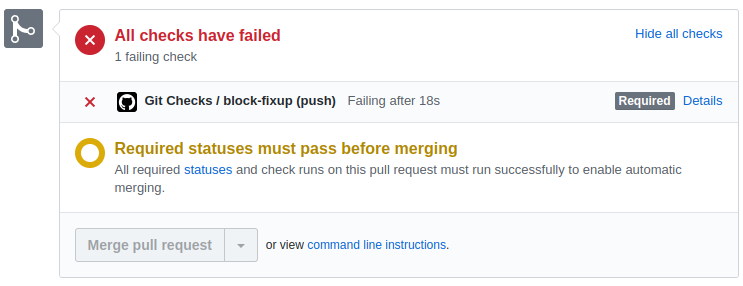Love using git commit --fixup to make minor cleanups to your Git history, but
forget to git rebase -i --autosquash master before merging?
Have I got a Github Action for you!
Create a file in your project named: .github/workflows/git.yml Add the
following:
name: Git Checks
on: [push]
jobs:
block-fixup:
runs-on: ubuntu-18.04
steps:
- uses: actions/checkout@v2.0.0
- name: Block Fixup Commit Merge
uses: 13rac1/block-fixup-merge-action@v1.1.1Optionally, setup Branch Protection to block merging of PRs against the master
branch with !fixup commits.
Example PR blocked by a fixup! commit:
Change Requests are part of a Pull Request code review. There are multiple methods to make the updates, some are better than others. The regular method is to add additional fix/update commits, including commit message titles such as "Code Review changes." There's a better way.
Git commits are the historical record of project. The commit messages tell a story, each commit or Pull Request describing a change. FutureYou™ and CurrentCoWorkers™ needs to know the end result of each change, but no one cares about edits required to make that change. We just want to read the book, no one cares what the editor told the author while writing the book.
One solution is to use Github's "Squash merge" feature. This works well for small PRs. A few small commits can be squashed into a single commit. The "edits" removed.
The problem occcurs when you have multiple unique commits a PR: a dependency
update, followed by a refactor, then a bug fix. It is all one contained change,
but FutureYou™ may just want to see that bug fix. Keep it separate. A solution
is using git rebase to edit commits during the code review; this becomes
confusing for reviewers, commits can suddenly disappear. "Fixup Commits" are
better.
Fixup Commits can added to the end of the git history during a code review, then squashed into their respective commits after the PR is approved. The workflow is:
- Make a feature branch.
- Add commits implementing features and fixing bugs. Rebase and force push all you want for now. This is your branch.
- Create a Pull Request and add Reviewer(s.) Rebasing commits is not allowed for now. This is not just your branch.
- Reviewer(s) request changes.
- Create commits using
git commit --fixup=<SHA>to prepare changes to existing commits. Make new commits only when the change is outside the scope of existing changes. - Reviewers see new commits and approve the PR.
- This is your branch again. Clean up the history to make an ideal set of
commits
git rebase -i --autosquash, and merge.
Note: Rebasing is still allowed for the entire branch to integrate master
branch changes as needed.
MIT
